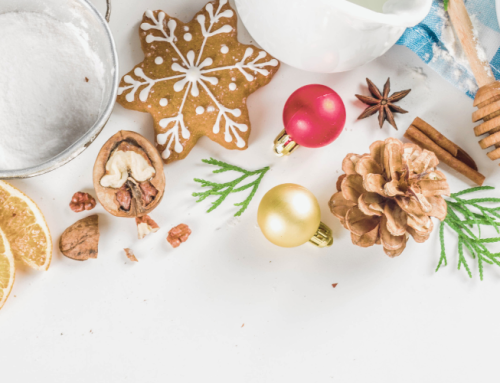Reading time: 4 mins
December is here once again – for many, this is one of the most anticipated times of the year, full of warmth, hope, and the company of loved ones. Can’t you already smell the freshly baked biscuits and hear the crackling fireplaces?
You may already be planning your Christmas dinner and browsing online for new recipes to try. If you have done so before, you have surely noticed that the way ingredients are measured typically falls into one of two categories: metric or imperial. The latter is most commonly found in US recipes, while the former is predominant on most European sites with culinary delights. It can be pretty frustrating when you find the perfect holiday recipe and it calls for cups of this and tablespoons of that, and measures in pints, ounces, and gallons. In baking, oftentimes the difference between a delicious end result and an unappealing sugary blob comes down to meticulously measuring the ingredients. Before you completely abandon your holiday spirit and turn into the Grinch, let us briefly explain the main characteristics of different units and how to properly convert them.
A teaspoon is a teaspoon… but is it really?
When you open up a US recipe, the ingredient list often charms with its simplicity: 2 cups of milk, 3 cups of flour, 1 teaspoon of salt… no scales needed? It sounds like a dream!
Indeed, it can be, but only if you keep in mind that not any old teaspoon you have at home will do. These are precisely defined amounts that have to be weighed – unless you have a handy set of correct measuring cups in your kitchen drawer. You should also keep in mind that cups and spoons are units primarily used for volume, not mass. You may remember your physics teacher explain that the two units are not interchangeable and depend on the density of the substance. When converting, it is thus advisable to find a conversion chart or online calculator for the specific ingredient.
Even if you have a set of measuring cups at home, it is crucial to know how to use them properly. For example, if the recipe calls for a cup of flour, the correct way to measure this is to fill the measuring cup to the brim and level off the top with a knife or spoon handle, removing the excess. You should also not compress the contents of the cup.
A what of butter?
Another common ingredient you may find in US recipes is a stick of butter. In the States and Canada, butter is often sold as a thin rectangular block (hence the name “stick”) that is very convenient for baking. One stick of butter equals half a cup, equivalent to 8 tablespoons – easy as pie! If you are a European, proud to have cracked the code of cups and spoons, you may still have a standard 250 g block of butter in your fridge. What now? Sure, you could soften it and measure it in cups, but sometimes recipes do not call for that. It is thus good to know that a stick of butter equals 113.4 grams. Perhaps you cannot completely get rid of your scales just yet!
Pounds, ounces, pints, quarts and gallons
Cups and spoons sound easy enough – they are a type of container one can quickly visualise and master. Some other imperial measurements, their meanings and conversions can make a metric mind feel like it has gone through a blender. Let’s break them down into bite-sized chunks.
Firstly it is good to know that pounds and ounces are usually (though not always) used to measure mass (dry ingredients), while pints, quarts, and gallons measure volume (liquids). To spice things up a bit, also keep in mind that the US and UK imperial measurements do not always match. A gallon of milk, for example, is equal to about 3.785 litres in the US, while a British gallon equals 4.546 litres – your cake may end up a soggy mess or dry as a brick if you convert using the wrong scale! Similarly, if you are offered a pint of beer in the UK (about 568 ml), you will be much more satisfied than you would be with a US pint, which is just 473 ml. If we tell you that many UK recipes nowadays list their ingredients in metric units, we trust you’ll be able to sleep in heavenly peace tonight.
Most conversions are relatively straightforward: 1 pound (or 16 ounces) equals 454 grams and 1 ounce equals 28 grams. 1 US pint (or 2 cups) equals 473 ml, a quart is 946 ml and a gallon is 3.8 litres. Things get saucy with fluid ounces, which are a measurement of volume, not mass, and where one fluid ounce equals 2 tablespoons or 30 millilitres. Fluid ounces are typically shortened to “fl oz” to differentiate themselves from regular ounces (oz). One fluid pound is equal to 16 ounces or 480 ml. The differences between the measurements for mass and volume may seem negligible, but remember – baking is a delicate art!
The (not so) infernal 400 degrees
Lastly, let’s talk about temperature. Apart from the US, most of the world is accustomed to the Celsius scale, so a recipe calling for your delicate pastry to be blasted for half an hour at 400 degrees may seem absolutely ludicrous – until you realise that’s in degrees Fahrenheit and equals a much more tolerable (for baking at least) temperature of just over 200 degrees Celsius. Your pastry is sure to transform into a crisp and golden-brown delight, turning heads, and making your guests’ mouths water, if you remember to open up an online converter or, if you have a knack for maths, use the formula: °C = 5/9(°F – 32).
Great tips, but isn’t this a translation blog?
Indeed, dear reader! The thought of freshly baked goods nearly led us astray, but let us devote a few sentences to properly translating (or more accurately, localising) units of measurement:
- First and foremost, when translating between two languages that do not use the same system of measurement (e.g., US English and Slovene), all units of measurement should be adapted to the target language and culture. This is true for more than just baking: distances in miles must become kilometres, inches must become centimetres, and square feet must become square metres, to name just a few.
- Remember that English uses points in decimal numbers and other European languages favour commas. Conversely, to separate thousands, English uses commas and other European languages use points. If an English recipe calls for 1,500 ml of liquid, that will be one and a half litres, not the few drops of milk you may splash into your morning macchiato.
- When typing out units of measurement in Microsoft Word, use a non-breaking space between the number and the unit by pressing Ctrl + Shift + Space instead of just hitting the spacebar. This prevents both elements from being split into two lines, facilitating reading and making proofreaders’ Christmas wishes come true.
The best solutions at a pinch
Online, you can find more measurement converters than one can count, helping you to quickly adapt a recipe to the system that makes you feel at home. Some recipe websites will also list ingredients in both units or may even have an integrated automatic converter. It is now easier than ever to find the perfect recipe and try it out, on both sides of the Pond.
We will draw a line at defining a pinch, a dash, and a smidgen, even though various attempts have been made online. What is life without a little bit of improvisation and risk? As for a cup of kindness – that can never be too full.
Our team at Alamma wish you peaceful and joyous holidays in good company and all the best in the New Year!
This post is also available in:
![]() Slovenščina
Slovenščina







Leave A Comment